Wayne Shorter was born eight months after Adolf Hitler became Chancellor of Germany. Wayne Shorter had a giant supply of human talent and artistic expression and is one of the most incredible saxophonists in musical history. His music immensely helped my mental health during the global pandemic that caused so much of our world to shut down these past two-plus years.
There is one period of Wayne Shorter’s music (that I’ve found so far at least), where he progressively published albums that, when savored over and over again sequentially, emotionally convey the soul’s sublime journey of the turning in on itself and then back out to the world again. Wayne Shorter builds an epic tale of descending into Hell and clawing back to the surface. Beginning with 1964’s Night Dreamer, Shorter shows us the human soul flipped inside out and back again. So let’s start with Night Dreamer, but first, we need to go back a few years to Wayne’s previous album, which was produced for another label and recorded in another city.
The city of Chicago looked like it was on fire. It was November 6, 1961, and steam billowed from the depths below ground. Still, it parted for Wayne Shorter, who made his way along the avenue toward the final recording session for a new record titled Wayning Moments under Vee-Jay’s production label. Wayne was ending his work with Art Blakey over the past few years. Art Blakey didn’t just create great music by bringing the most talented musicians together on stage and in the studio; Blakey created incredible artists. Famous for giving his musicians a place to develop themselves individually within the context of a group making music for the living moment, pick up any Blakey album across the decades, and you will be transported into one of the dozens of musical conversations about the things that matter to our short, flimsy, and important lives.
Wayne Shorter entered Universal Records studio and walked to find Sid McCoy, the engineer, and the fellow musicians he’d be playing with for this recording. They all readied their instruments, poised and waiting for McCoy’s signal to play. Finally, the sign is given, and Wayne Shorter’s tenor saxophone starts shouting out lovely and lively combinations of notes played over the chord changes as they were passed off between the rhythm of the double bass and drums and the melodies of the trumpet and piano. Wayne Shorter was starting to understand how to paint with sound, but he wasn’t the only one, and he wasn’t the first one. Another gargantuan musical visionary and talent, John Coltrane, also used the saxophone to carve out unexplored and exceptional sonic spaces inside our collective human soul.
Wayning Moments was recorded on November 6th, 1961, at Universal Records, Chicago
Wayning Moments was technically perfect in many ways; it also barely belongs with these other records. It wasn’t a Blue Note record and is far too pristine. But it’s an excellent place to measure how far we go in musical storytelling. When you listen to this album, you will know that Wayne Shorter is a musician capable of creating perfection from his musical ability. However, the musical narrative we are about to walk through requires the act of destruction and creation. Unfortunately, music that destroys to create is scarce, and my primary reason for writing this essay is to celebrate this gem of artistic scarcity.
The songs were a potent blend of Shorter’s compositions and key selections from other artists whose work allowed him to build entirely new expressions from the ground up. How incredible that we live in a world where one artist can pick up the work of another, even from other times, and create something new and exciting that shines a light of appreciation on both versions of artistic expression.
But perfection in Jazz music is a lie. This is a truth you can’t look up anywhere. You either feel it, or you don’t. And these songs are too perfect, well made, over-polished, and shiny when combined. Shorter left Art Blakey’s band, a new kind of musician. He was now playing with Miles Davis, who was digging all kinds of tunnels in entirely different areas of music than Wayne had excavated with Blakey. Miles Davis gave his musicians a different sort of freedom, the freedom to follow with humility and grace. There is a time to lead and a time to follow; the wise know which before it happens, and the lucky realize it afterward.
Something seemed to have unlocked inside Wayne Shorter’s heart in the two and a half years between that cold Chicago day and the pleasant late Spring day in Englewood, New Jersey, where we started this journey together. Wayne Shorter was ready to start telling a different story that may not have made sense to him back then. I doubt that Shorter understood how the next three years of work would progress. I write this not because I know but because I strongly feel that proper art, in James Joyce’s definition, is not created by intention but by emotional reflection channeled through artistic expression in the living moment. That’s not mumbo jumbo to me. I’ve experienced moments of composition that evoked my spirit to ascend beyond where it was before I started typing. That, to me, is one of the great experiences of being alive, being able to express myself in a creative bit of nothing that feels like everything. I wonder if Wayne Shorter felt this ascension when he started playing sounds into the microphones at Van Gelder studio because I sure feel it when I listen to this record with knowledge of the journey to come.
Night Dreamer was recorded on April 29th, 1964, at Van Gelder Studio, Englewood Cliffs, New Jersey
Night Dreamer is the first song and the title of the first album in this journey, and it begins with a lovely and cascading roll of the piano that leads into the swaying horns of Shorter’s tenor sax and Lee Morgan’s trumpet. These two men create an emotional scene that reminds me of the moments in The Nutcracker when you suspect and then know that Clara is now asleep and dreaming.
If Wayning Moments was about bopping around a crowded city on a beautiful day, smiling at everyone you saw, Night Dreamer is about what happens after lying in bed after a very long day of walking, those soothing seconds when the body feels its burden lightened and settled into comfort. These are moments of bliss, and this first song captures that feeling and will shepherd the listener through the gates of the dream, where chaotic forces will draw the dreamer across the darkness to the edges of mortality.
Night Dreamer is a record that calms the needle of my soul by dragging it through these grooves. It tells the story of a dreamer floating through layers of dreams painted in sounds that move erratically but with grace. Nietzsche wrote that when one stares into an abyss, the abyss gazes back. Maybe you agree that Night Dreamer is a story of descent into darkness and solemnity. With its final song, Armageddon, this record has delivered its Hero and we, the listeners, to a deep new arena of the spirit, where something sublime will happen to us all.
Nat Hentoff interviewed Wayne Shorter for the essay on the back cover (Blue Note Records have truly excellent essays on the backs of their albums). One gains directions for listening to the record from these essays on what to think about as you focus on the sound; this instruction is the hallmark and purpose of significant criticism. In this interview, Shorter makes a few statements that give us insight into his feelings when he and these musicians created this work of art.
Shorter told Hentoff:
“What I’m trying to express here is a sense of judgement approaching—judgment for everything alive from the smallest ant to man. I know that the accepted meaning of Armageddon is the last battle between good and evil, whatever that is. But my definition of the judgement to come is a period of enlightenment in which we will discover what we are and why we’re here.”
We deal with dark swirling forces that float through beams of light, but the light grows more intense the closer we get to the edge of consciousness, where even the dream must settle down into the depths of our universal mind. This brings us to Juju.
JuJu was recorded on August 3rd, 1964, at Van Gelder Studio, Englewood Cliffs, New Jersey
Three months later, Wayne Shorter was ready to record the next exploration phase in the underworld of the human psyche. This record loses Lee Morgan’s horn, leaving Wayne’s tenor saxophone as the only brass statement, but he makes up for the trumpet’s absence.
This album starts in a wild cacophony, a frantic disruption of the soul with the title song Juju. Again, we are staring into the abyss and witnessing the unknown staring back at us. This milestone of disorder is a much different emotional scene than what we left in Night Dreamer, yet we can hear faint callbacks to some of those questions asked in the last album. With our identity moving from objective to subjective, as in dreams, we suddenly confront a force beyond ourselves as the dreamer alone.
Deluge asks a question and gets an answer over and over again. Does the answer change by the end of the song? That’s up to each of us to judge for ourselves. It’s a complex but beautiful inquiry, petitioning someone to see if they are pure of heart, an honest question seeking a direct answer, which I believe is given by the end of this song. Shorter’s sax starts very confident and open but is soon joined by the piano, and they swing in a joyous rhythm of commitment, underscored by the drums. This is a marriage song. Shorter told Nat Hentoff:
“In the opening statement of the song [Deluge], I tried to give the feeling of something coming down—descending octaves—and then overflowing.” The soul has wrestled with its dark side and finally accepted it.
This record works through some dark forces but ultimately comes out triumphant. I feel like there is either a balance restored by the last song, Twelve Bars To Go, or light has indeed overcome darkness, if only a little. When asked about the positivity in the record, Shorter told Hentoff:
“Since being with Miles, I find my playing has steadily veered toward expressing the happier side of life.”
Night Dreamer moved us from the waking world into a world of amorphous and, at times, chaotic dream life, where identity dissolves and morphs, becomes subject and object at once and then dumps it at the edge of a dark and wild abyss. Standing on the edge, casting our soul’s attention into the abyss, is what Juju shelters us through. By the end of this album, we see both sides clearly, and it is up to us to choose. As for Wayne Shorter, he walks back into Van Gelder studio on Christmas Eve, nearly four months later, to record a masterpiece that says very clearly what his main character is going to do after staring into the abyss and seeing both the darkness and light that resides within us each and all.
Speak No Evil was recorded on Christmas Eve, 1964, at Van Gelder Studio, Englewood Cliffs, New Jersey
I have much to say about this record, but it ties my tongue up. You must listen to it in its entirety, preferably in a low-lit room with no distractions, your favorite beverage close by, or maybe a dog or cat curled up in your lap. Close your eyes and slip on your headphones, or turn the music up until it surrounds and comforts you without agitating. Go on this journey alone and then come back to tell others about it like I am working on saying to you now.
Blue Note President Don has steered me right in the path of Wayne Shorter’s gifts. A few years ago, I took a chance on a vinyl record box set from Vinyl Me Please to celebrate the 80th Anniversary of Blue Note’s excellence. I didn’t know much about Jazz music then (I still don’t know enough right now). As Ted Lasso says, “I got curious” and vowed to stay that way about Jazz music. Like Bob Dylan and Twin Peaks, Jazz will be a lifelong puzzle that I work my soul against solving or at least coming to an emotional stasis of understanding. This record, Speak No Evil, is the one that made me truly fall in love with the emotions that Jazz can make me feel like no other music has done. And Don Was steered me to Wayne Shorter’s album Speak No Evil in the podcast that the purchasers of that box set were sent. I am forever grateful for that recommendation from Don Was.
With Jazz music, I ask myself, What would happen in a scene in a film that was scored to this song right now? This question is an excellent starting point for identifying the emotional tone of the music you’re listening to. Once the emotion is identified, one can better place it in the proper context, asking the next question. What are these instruments saying to each add or detract from this mood? Sting sang to us that we are all spirits in the material world, and Jazz is a conversation between the spirits of musicians through their instruments in the improvised and living moment. The best Jazz music is a complex conversation where different instruments say different things. True diversity in musical expression is difficult to achieve in other forms of music, especially those that involve someone singing lyrics.
There are only six songs on this record; for me, they are a continual conversation between good and evil. Here’s what seems to be repeatedly happening with the calls and responses we hear throughout the songs. The rhythm is the constant drumbeat of what evil says in the conversation. Ron Carter’s bass fuels the fire that Elvin Jones lays down in the most masterful swinging and swaying waves of groove.
The voice of Evil is always surrounding us and informing the world; it may also be the ground we walk on. Of course, Good is represented by the horns. Freddie Hubbard’s trumpet melts with Wayne Shorter’s tenor saxophone, and they weave a golden rope around the rhythm, leaving the melody to decide for itself. Herbie Hancock seizes the void between the parties and gives us a vehicle to ride on this journey. Good should pierce the rhythm and pull the melody towards what it has to say, which (for me) is the following, over and over:
Good Says To Evil: “I see you.”
“I see you clearly.”
“But forgiveness and mercy are stronger than your pain.”
“And here is what that mercy feels like...”
Listen to the title song for the album, and you may agree with my premise here. This record slaps forever and all time. As an album of music telling a story, Speak No Evil feels like Christ turning away from the Devil after the last temptation. But it doesn’t have to be that dramatic. The best of us turn away from evil every day. This record is a fork in a soul’s journey toward enlightenment. Interviewed by Hentoff again, but for this album, Shorter said:
“I was thinking of misty landscapes with wild flowers and strange, dimly-seen shapes—the kind of places where folklore and legends are born. And then I was thinking of things like witch burnings, too.”
Now, my own experiences with this record came into my life shortly before I first visited Scotland. I will write about that experience under a separate banner, but I will summarize by saying something remarkable happened in my heart just stepping off the plane in Inverness. I was lifted. I was home in a way I’ve never felt when visiting an alien landscape. I could feel my Nordic and English ancestry stir in that land. This album stokes that fire inside me. I experience a depth of righteousness whenever this album concludes, and I always fight the urge to flip the record over and hit play again on the turntable. What a blessing it is to find art that one can continually walk through while finding new rooms filled with different emotional alchemies.
Speak No Evil is the power of righteousness at the moment before it becomes humble in the presence of the divine. This leads us to the next album, The All Seeing Eye.
The All Seeing Eye was recorded on October 15th, 1965, at Van Gelder Studio, Englewood Cliffs, New Jersey
You are dreaming, and you’ve traveled far on this vessel of rhythm, harmony, and melody over this past year. We had just made it through a world of mist and legend when we last left this journey. We wrestled with the Devil, and both walked away exhausted. The mist parts, just at the end, and we are staring at what appears to be...
…The All Seeing Eye.
If you’re Wayne Shorter, you’ve got to know in ’65 that you’ve already created an epic tale on the scale of Lord of The Rings. The soul has journeyed so far by the end of Speak No Evil, but as the man wrote, time is short, so you gotta keep on keeping on in the service of whatever it is that we each call lord. You gotta serve somebody, after all.
At the beginning of this record, the listener is being questioned alongside the Hero we’ve been shadowing this whole time across three albums. So now we are in the hot seat in front of this...being...entity...what would you call it? Remember that scene in The Neverending Story where Atreyu comes to the oracles who will shoot him down with eyeball laser beams? This feels like that moment, and I’m here for every second.
In the Pilot episode of Star Trek: The Next Generation, “Encounter At Farpoint,” the Enterprise D crew encounters a god-like being who can create a reality around them. John Delancie’s Q is one of the most significant characters created in a fictional narrative. A true trickster, Q is not entirely malevolent. He is beyond good and evil and stands in the judgment of every human being. Does such a cruel creature as Humanity deserve even to continue drawing breath? Q sets out to determine this when he puts Captain Jean-Luc Picard on trial as the primary spokesman for his species’ banality, weaknesses, and terrible choices.
That trial is also happening in The All Seeing Eye, where we walk through the brutality of our shared history, understanding that historical events are composed of human beings behaving in the living moment as if there were no mercy or salvation, and that is a spiritual sin that has spawned an ocean of moral crimes.
There is a large cast of musical voices over these five epic songs. After all, when the entire species is judged for a spiritual crime, it deserves to be a spectacle. Freddie Hubbard adds the flugelhorn to his trumpet. He is joined by Wayne Shorter’s brother, a great musician (bless their families for supporting them in pursuing music as their gift to the world), supporting Hubbard with a second flugelhorn. Grachan Moncur III rises to the eminence of his name with the trombone. James Spaulding wraps the output of his alto saxophone with Wayne Shorter’s tenor saxophone to create a single, complex voice. Look at all this brass that Wayne brought to speak for the best of humanity. Like Picard and his trusted crew, all this brass will join together and argue before The All Seeing Eye that mankind is worth saving despite our sins.
Honesty
Humility
Mercy
Ron Carter’s bass and Joe Chambers's doubtful drums create a thin-lipped response to the evidence presented before the court’s honor. As humble citizens, we must become penitent before the Law as it has been written on the human heart since the dawn of consciousness. When man’s law veers from that universal law, trauma and strife are the effects of that unnatural ripping away. The All Seeing Eye is the story of our species begging for another chance at redemption.
So we’ve been introduced to the almighty in the first song, which is also the album’s title. The next song is Genesis, and Shorter had this to say on the back cover of the album when it was published:
“Genesis goes into a 4/4 straight time to indicate that everything is beginning to settle down, routines are starting, patterns are emerging. There are clusters of stars species of life. And overall, I tried to give Genesis a feeling of open-endedness because once creation begins, the creative process keeps going on.”
Carl Sagan probably loved this song if he ever heard it because he told this story a million times throughout his life. He thought about it and talked about it to others. Carl Sagan found a profound spiritual truth through science's behaviors and language. Simply studying the natural world by staring at it without judgment can allow for a tremendous and deep reservoir of humility and gratitude, the genuinely religious experience in our lives.
For the next song, “Chaos,” Shorter says:
“Chaos is what man has done, to a certain extent, to God’s creation. The music mirrors conflicts, wars, disagreements—the difficulty men have in understanding each other. As for its structure, it moves—in its use of time—from fighting with clubs and bows and arrows to the atomic age and beyond. You can hear, for example, the age of gun powder being introduced in a particularly staccato section.”
When we make it through the chaos of our trauma-filled history, we are met with the “Face Of The Deep,” which is the moment of judgment. We might expect cruelty, but we are satisfied with tenderness instead. This is the mercy of your Lord, whatever face you choose for it. Even cynicism is a religion with an idol and rituals. Here is where we lay down all those burdens of the past, where we walk away from the hope that institutions will save our souls. They won’t.
And finally, like Agent Dale Cooper in the final moments of Twin Peaks The Return, we must sacrifice even our most sacred identities by emptying our pockets of memory; all the precious and terrible moments of our existence pour to the floor and turn into dust that dissolves and wafts away into the same mist that we journeyed through to get here. We are naked and empty before The All Seeing Eye. Shorter said this on the back cover:
“Face of the Deep is hopeful..the indication is that we don’t know what will happen and therefore, there is still hope..I wanted to indicate that God’s thought processes are so powerful that He can overcome all of the goofs of man and some of His own too. He keeps thinking forward. When I say some of the goofs may be His too, and that possibility is raised in Chaos as well—I mean that if He had wanted to create a world without conflict, He could have done it.”
And there we have it. The All Seeing Eye is asking for our forgiveness. The price of that forgiveness is that we must always deal with the extreme opposing force that manifests in this character of chaos named Mephistopheles, the machine maker. We must learn to co-exist with this annoying entity of malice. The last song, "Mephistopheles,” reveals this character who will sing sweetly to us in the next album, Adam’s Apple. The last minute is a war cry right in our faces. The Devil just threw down the gauntlet and wants to know what the fuck we are going to do about it. A playground bully who just slapped the precious coins out of our hands and scattered them all over the ground. With that last scream, the Devil pushes us hard to the floor and stares down at us, mean and hateful, daring us to get back up.
“Once you begin thinking about the nature of the universe and the nature of man, there’s no way of stopping. It’s all so open, so without finite limits. The universe keeps changing, man keeps changing, and I keep changing.” - Wayne Shorter.
Adam’s Apple was recorded February 3rd-4th, 1966, at Van Gelder Studio, Englewood Cliffs, New Jersey
Nearly four months after recording The All Seeing Eye, Wayne Shorter walked back into Van Gelder Studio on a late Winter’s day, almost two years after the first session where they recorded Night Dreamer in this same studio. In the life of an artist, this had become a period of immense critical value. These records were vital. They still matter, equivalent to a sound sculpture on the level of Michelangelo’s David or the ceiling of the Sistine Chapel. Hell, the story is the same story on that ceiling in Rome.
Mephistopheles is not all fire and brimstone. That villainous character can groove as no one else can, and it also speaks in the language of horns. There is a reason the proverbial Eve was seduced by the snake's hissing. Adam’s Apple is all about taking that precocious first bite. In Batman (1989), the Joker asks his prey, “You ever dance with the devil in the pale moonlight?” In Pulp Fiction, Jules Winnfield quotes the Bible Ezekiel 25:17 about feeling god’s wrath through a finger that touches you after being judged and found wanting. There’s that spiritual crime again. The path of the righteous cleaves through the inequities and tyranny of selfish and evil men.
The human being who speaks no evil passes through the land of shadow under the protective gaze of The All Seeing Eye. Judged and found willing, the righteous one is released to walk in grace even under a cloud of darkness. But you gotta give the Devil his due, which is what Adam’s Apple is about.
The instruments and musicians are a fraction of the crew that came together for The All Seeing Eye. Shorter is the only brass with his tenor sax. Herbie Hancock regulates the temperature on the keys, and Reggie Workman’s bass melts into Joe’s Chambers to pace the rhythm of Mephistopheles’ groove. When the final song, “The Collector,” ends, and the listener is released to the final phase of this epic journey, it feels like a symbiosis has been reached. A being as complex as a human can never be completely good or evil. Like these horns that solo on top of this piano that meanders between the polarities of morality, the human being drifts in space, pulled by the gravity of a force greater than ourselves in many directions over what feels like a long period. Perhaps emotion is dark, which holds together objects in space separated by vast distances with little light.
By the end of Adam’s Apple, it’s time to return to the waking world, what will become the opposite of that happy, bouncing, and fake smiling person from Wayning Moments so long ago. We have forgone the luxury of joy through blissful ignorance. We have stood before The All Seeing Eye, and the wormy tongue of Mephistopheles has assaulted us. Now, the Hero must walk between polarities and move beyond Good and Evil with the righteousness they have maintained from the beginning of this journey.

Schizophrenia was recorded March 10, 1967, at Van Gelder Studio, Englewood Cliffs, New Jersey
We’ve got a flute, friends. Four brass instruments welcome us back to the waking world. Shorter’s tenor sax, Curtiss Fuller with his trombone, and James Spaulding played that flute and the alto saxophone. Herbie Hancock is back on the keys, and Carter and Chambers are back together on rhythm, having not played with Wayne on an album since The All Seeing Eye.
I want to briefly discuss the epic story emoted over these six records (not counting Wayning Moments) in terms of this diagram illustrating “The Hero’s Journey,” as was taught by Joseph Campbell (1904-1987), the late master of Human Mythologies, Anthropology, Psychology, Philosophy, and Cosmology. Consider this diagram as a journey that begins at noon with the Call to Adventure, where the protagonist feels a deep uneasiness and finds some helper that guides them to the threshold where there is no turning back after the choice is made to descend into the underworld. This all happens in Night Dreamer.
Things turn dangerous once the Hero descends into the underworld to face their trials. They could be killed and dismembered, forced to sacrifice everything, and then scattered to the winds by cosmic forces much more significant than they could ever hope to be. Instead, the Hero confronts forces of judgment and mercy far beyond good and evil, ancient and complete. This happens in Juju, where the Hero has proven their worth to the grand judge, deriving authority from the universe and whatever force of intelligence created it. The Hero has been granted the gift of light to bring back to the world. But there are still trials on the outward flight back to the waking world. In Western mythology, this obstacle comes from Mephistopheles, who we are introduced to later in the final song of The All Seeing Eye.
Speak No Evil is where we wrestle with understanding and accepting the nature of Evil, where our Hero wrestles with the Devil and turns him away like Christ did all three times (and maybe a fourth if you count The Last Temptation, which I always do). The Hero of this story traveled to a spiritual and intellectual place opposite from where they descended into the underworld. They have begun their flight back to the world, which will offer new trials that often involve an ordeal of resurrection. Christians consider this the second birth. Similar concepts are equally poetic in expression and form, but they all say the same thing in the end. They are lost, and now they are found. They were blind but now can see. These lyrics from Amazing Grace bring tears to my eyes if they catch me giving them suitable attention.
That story of redemption, forgiveness, and grace through humility is one that I can rewatch and appreciate over and over again. It’s Star Wars. It’s Lord Of The Rings, Harry Potter. It’s Twin Peaks, and This Is England. All stories I adore rereading and rewatching. But I’ve never found it in an album before, not even where it should be with records like Pink Floyd’s The Wall, a story never quite slaps hard enough to leave a mark, despite its perfection. But these Wayne Shorter records do. I think about them often when I’m not listening to them. I try to remember the riffs in those calls and responses. I can usually get pretty close. It puts me in the story, and I’m ready to listen to it all over again.
So the Hero, rising out of the underworld where they confronted forces of darkness inside the soul and psyche, now stands before The All Seeing Eye with total humility, on bended knee, head down. The light they have carried from the depths of all existence is now blessed by supreme knowledge with divine intelligence. Light fused with knowledge is the gift that must be brought back to the world to reforge what was torn apart but still so sacred that it can never be destroyed. In Twin Peaks: The Return, this is represented by the golden seed of all that is good within Agent Cooper. He has to smuggle it through his nightmare to save his soul. In Wayne Shorter’s epic, we have gone through the trial of ordeals with our Hero and now stand with them before The All Seeing Eye.
We are given a tour of the history of trauma that is life. We are judged and shown mercy, but with a catch. We must live with Mephistopheles in our ears daily, but we must never let that creature into our hearts. It’s the price we pay for the blessing of mortality, to each know ourselves as a unique collection of experiences smeared across emotional collisions through time.
Finally, the Hero leaves the gaze of The All Seeing Eye and begins the journey home with the elixir of life, a precious totem or piece of wisdom that will heal the world. The first leg of this trip back is Adam’s Apple, another conversation with Mephistopheles. Have you ever danced with the Devil in the Noonday Sun? They agree, and from the emotions I detect in myself after listening to and considering Adam’s Apple, I think the Devil is laughing at the Hero. In my mind, Mephistopheles is saying, “Alright, young one. Do you think you’re a badass with that little golden orb of yours? Go ahead and take that into the world and see what happens. This is my world, bitch. Good luck!” Laughing at the Hero as they walked away.
And, sure enough, when the Hero tries to take that little ball into the world, people slap it out of his hands and stomp on it with their muddy feet. They kick our Hero when they bend down to grab it and try to protect it. No one wants to know about that little orb, bringing us to Schizophrenia.
What does a magician do with the magic no one wants to see or hear about? Does the magic dissolve if it doesn’t find an audience to witness its evocation? There is a good chance the Hero will develop a psychopathic breakdown. According to the album’s back cover, written by Leonard Feather:
“Schizophrenia, in one of the strict dictionary senses, refers to an enormously complex emotional disorder, involving distortion of the usual logical relationship between ideas, a separation between the intellect and the emotions, a retreat from reality. In the more common sense, it simply means a split personality.”
This is all part of the Hero’s journey, and the successful ones make it through the mental and emotional breakdown of having all this magic and no one to cast it on and save. Consider the social media platform algorithms that amplify hatred and negativity because they’re the path of least resistance to stimulating engagement. We each suffer minor psychological breakdowns daily just by participating in this wreck of human society as it has been redefined through the Mephistophelian lens of whatever this evil Metaverse is about to become. The question is always about getting back up when you get knocked down.
So the Hero comes swaggering into this old world that feels like a New World to them. But it’s still the Old World for everyone else. That swagger of faith is fully displayed in the opening song “Tom Thumb.” The next song, “Go,” is the world’s response to the Hero, “Go pound sand, asshole!”
And so we get a potential schizophrenic crack-up. Will the character be foolish enough to identify with The All Seeing Eye? That’s a sure path of martyrdom and torture in a world that is only too happy to keep nailing people to the cross of their unfortunate circumstances. Life is regrettable, after all, because it ends. But the other side of that assertion is that life is glorious because it ends, that the ending is what brings the potential for definition and distinction. The border of death in our lives gives us the appreciation of existence as a fleeting experience filled with an ocean, nay a universe of it over time.
The Hero will either succumb to this Kryptonite or become Kryptonite. To succumb or become is the final choice of the Hero in this journey. Some don’t make it. Their stories of failure at the gates of Paradise are sad. But those Walter White stories of loss and tragedy don’t mean as much as the Heroes who overcome this final barrier of their ego and hubris.
We know that our Hero in Wayne Shorter’s story has chosen to become that Kryptonite and continue casting their bread over the water. Listen to “Miyako” and know that our Hero has made it safely through that breakdown and is ready to cast his bread on the water, even with no creature to receive it; this is key for the Hero to maintain their precious sanity. Faith floats where needed in this world, and farmers must sow seeds with complete confidence that they will grow over time with care and attention by the earth that receives them. Isn’t it nice that things tend to grow where we plant them?
The final song of this journey is titled Playground, and our Hero finally sees the world as a playground filled with necessary suffering. Consider what Professor Campbell has to say about this in The Power Of Myth (1988, Doubleday Hardback First Edition):
Conclusion: The End Of Wayne Shorter’s Blue Note Hero’s Journey
Life as a playground is an excellent metaphor for what we each live through daily; a playground filled with suffering abounds. But there is also a chorus of childish laughter and screams of joy. No demon was slain during our journey here, but demons were overcome. It’s more adult to think about overcoming challenges rather than killing someone to try and solve complex problems, which is all so childish.
In the end, each may mean the same thing, but if we are lucky enough to live in an environment of relative security with general respect for the Common Good through Common Law, may our only demons to overcome be the metaphors of the dark forces that lurk in our hearts as we struggle to live with them every day of our lives. The best art helps us with this burden by imparting the wisdom we need to unlock, both intellectually and spiritually, our ability to become humble before The All Seeing Eye, which gazes at each soul in unique ways; this is what I’ve learned from my time enjoying these six records of musical storytelling.
Every night, we descend into an underworld of consciousness in sleep. For my part, I believe that I have experienced the lowest depths of the deepest edge of my existence as a mortal soul drawing breath on this planet. I have stood before my own All Seeing Eye and learned why it makes more sense to be kind rather than cruel, that there are times for war, but that all time is for peace. I believe Love is a force of nature, antecedent to all others. These are all just my dumb beliefs that I lean on like fractured crutches, which I use to bumble around this children's playground.
Now and then, as I bumble, I stumble upon some fantastic unit of human expression about this journey of our soul’s redemption. I pick it up. I stare at it for a while and put it in my pocket. I fuck with it in my pocket all day, fingers drawing traces around the surfaces, learning it from different angles. I’ll pull the gizmo out and stare at it. I’ll shake it next to my ear and see if it rattles. And then I’ll set it on the table and walk around it, looking at it in different lights from different angles. Then I sit down and crack my knuckles because it’s time to get to work. This is the best way to describe how certain expressions of art have chosen me to write about them. I often trip over things because I’m looking up at the sky when I should be looking down at the ground. Most critics stare at the ground and never trip at all. How unfortunate for them.
The three years (1964-1967) during which these records were produced followed the death of a President and the death of many dreams of Justice around the world. Too many people stared at the sky or looked down at the ground. More of them should have been paying attention to what they were walking into straight ahead. This is still our problem.
The artist enjoys the luxury of staring at the sky as much as they desire. But the artist is a Human before they are anything else. And the Human Being is a Citizen before they can ever be an Artist. Citizens share respect for one another and adhere to the Common Law as a measure of the Common Good.
For my part, I’m one of those rare middle-aged starry-eyed dreamers who still believe, despite the reasonable cynical conclusion, that art can heal the world by changing the internal emotional landscape of any Human Being alive. In this essay, I have labored to explore what I found to be a profoundly moving narrative being told over these six records that Wayne Shorter recorded between 1964 and 1967.
A lot can happen over three years. Jesus’s entire ministry was about that long. In three years, civil wars are fought and lost by everyone on all sides. But it is also possible for Human Beings to rise above themselves in the living moment and string them together like prayer beads into the most incredible soul expressions over three years. What happens when one of the world’s most brilliant and talented musicians brings together the most talented musical teams for different sections of the most epic story they create through sound? I hope you’re about to discover this experience on your own.
These musicians who created the rhythm and melody that allowed Wayne Shorter to solo his tenor saxophone, blended with all those other outstanding horned instruments, assigned that brass as the voice of the Hero in this journey of descent into the underworld to conquer the dark forces within the soul. Then, the Hero ascends to be granted an audience with The All Seeing Eye. Here, they are judged worthy to return to the world with a boon of salvation. Unfortunately, this journey through the counsel of the repulsive Mephistopheles sees the Hero returning to a world that neither recognizes nor receives this boon brought to them through the flames of desire and fear. So, what is the Hero to do now?
The Heroes that proceed onto the Playground are the ones who lay down their pain, joys, mission, and ultimately their identity. Like poor Agent Cooper, who doesn't even know what year it is at the end of Twin Peaks, the Hero stumbles forward without a light. Yet, they continue to do the work, to cast their bread upon the water. The Artist’s valid reward is not money or fame but the experience of Nirvana in the living moment. Consider this statement from Wayne Shorter himself on the back cover of the final album of this series Schizophrenia (Blue Note Records, 1967):
“When you’re playing, the music is not just you and the horn—the music is the microphone, the chair, the door opening, the spotlight, something rattling. From soul to universe.”
Here is a list of all these albums and songs for you to enjoy and think about:



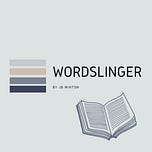

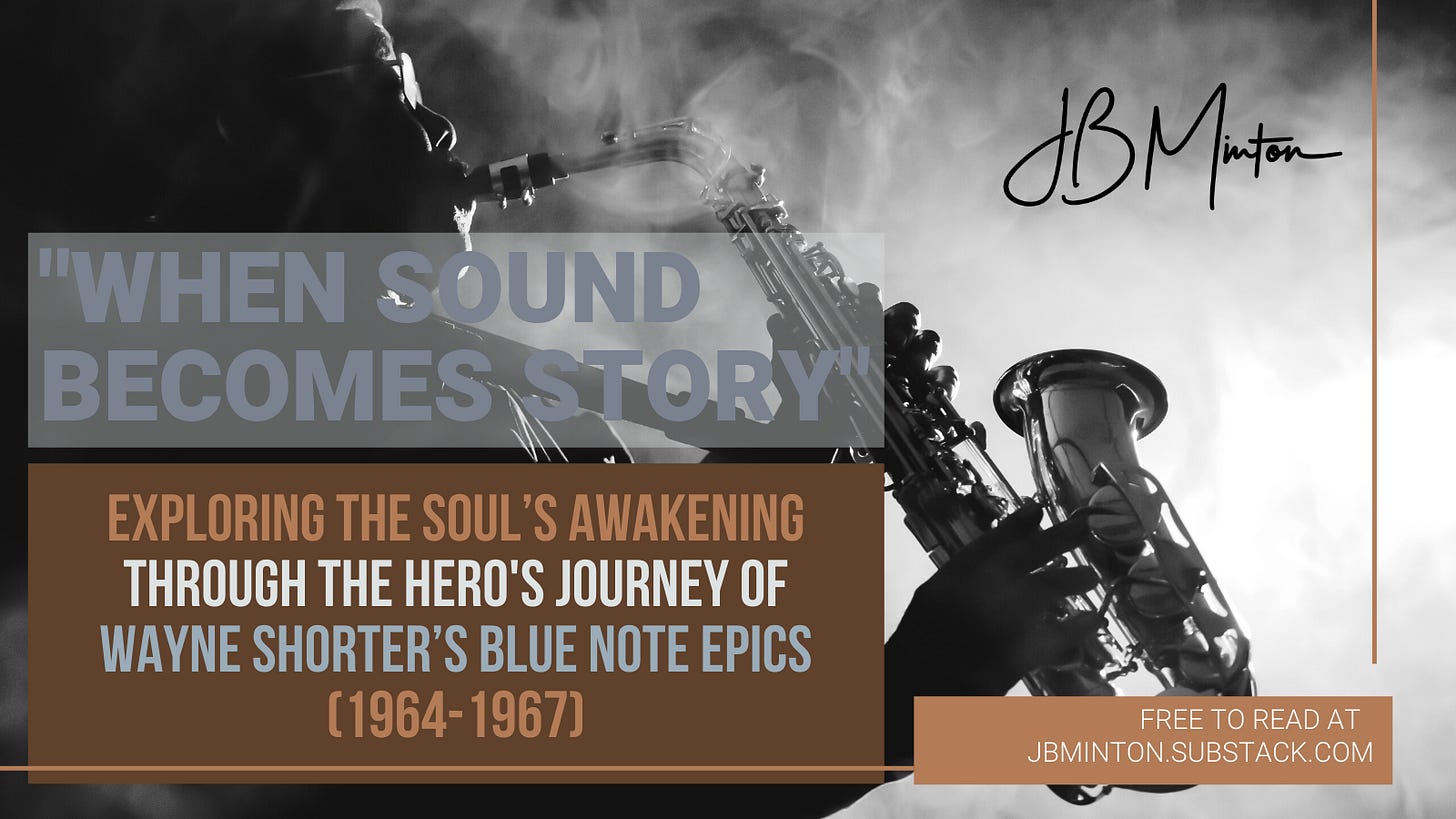




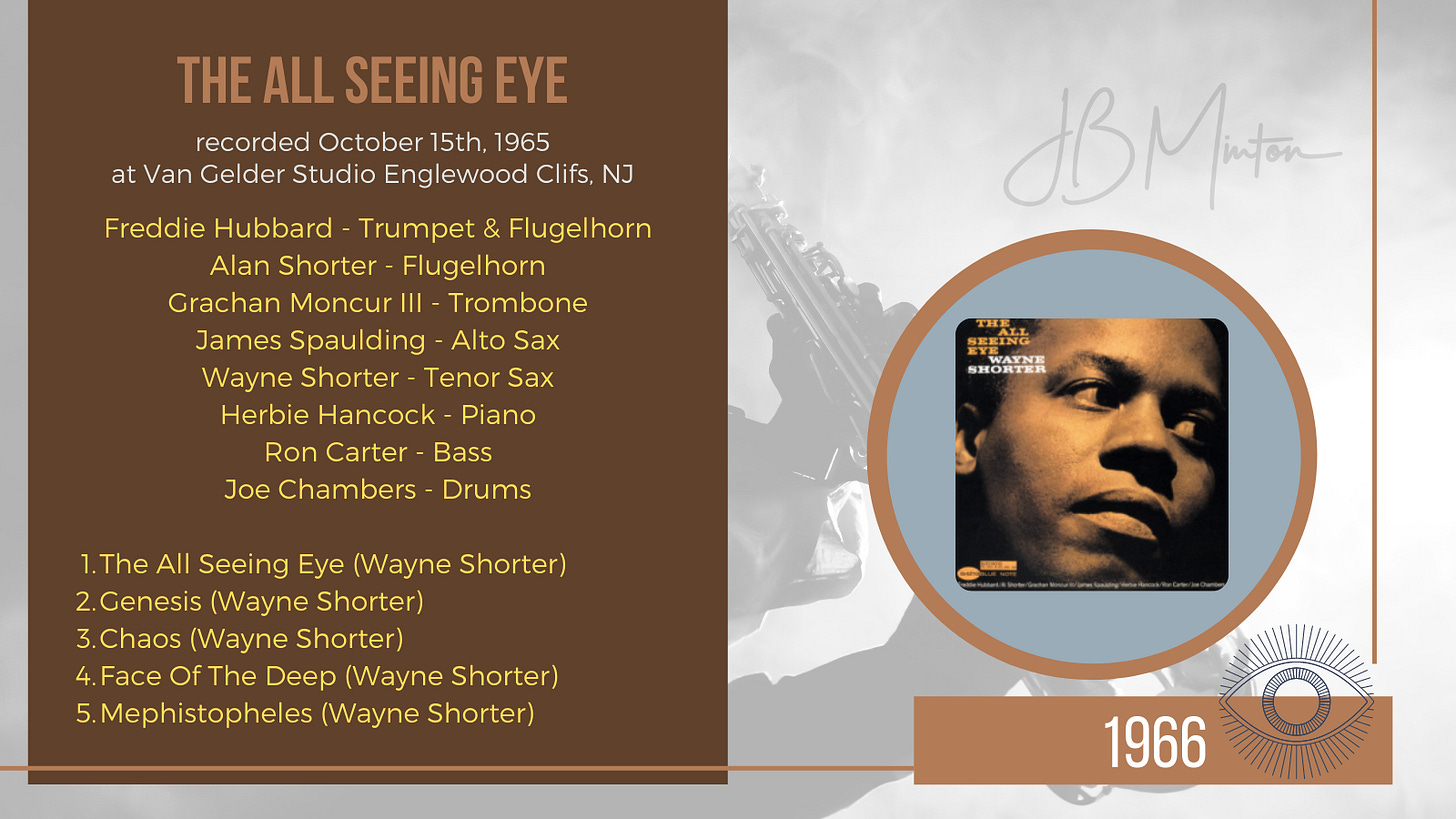




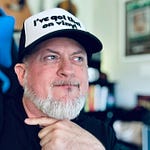



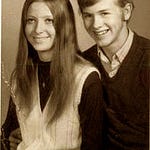
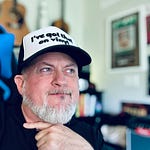
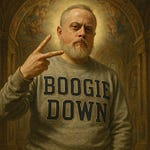
Share this post